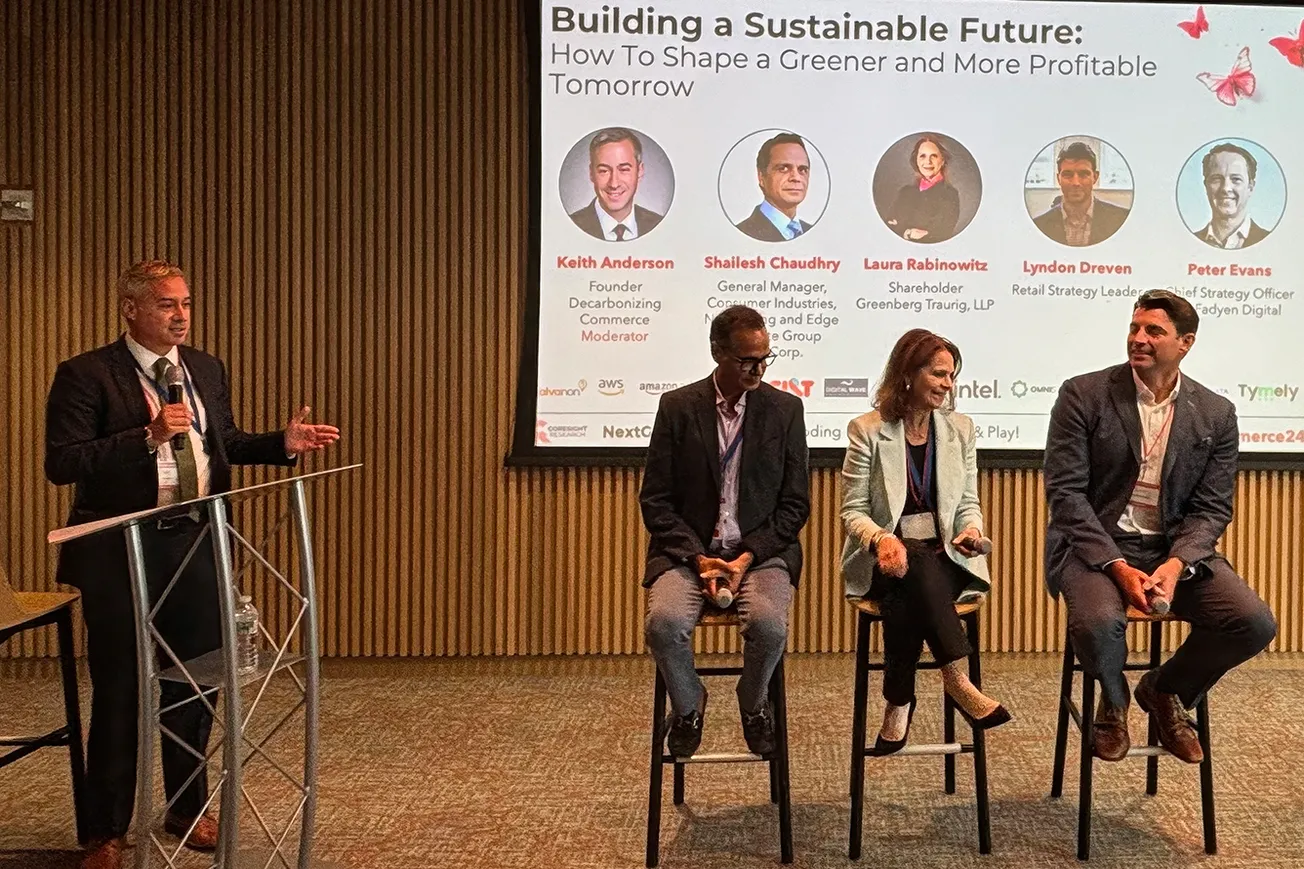NEW YORK — Artificial intelligence (AI) and other technologies have the potential to help retailers and suppliers make their businesses more sustainable, according to panelists at Coresight Research's recent NextGen Commerce24 conference. The conversation — titled "Building a Sustainable Future: How to Shape a Greener and More Profitable Tomorrow.” — pointed to the value of seeing sustainability as a strategic business opportunity rather than just a compliance requirement.
Sustainability as a Growing Priority
Keith Anderson, founder of Decarbonize.co, a commercial sustainability advisory firm for retailers and brands, kicked off the discussion by noting the exponential growth he has seen in corporate sustainability commitments.
"Over the last four years, there's been exponential growth in SBTI (science-based target initiative) and other sustainability-related commitments by retailers and brands. And commitments don't necessarily translate into action. But the second notable exponential shift that I've seen is that more than $20 billion of capital has been invested into technology that, as part of its value proposition, is trying to help retailers and brands advance their sustainability goals in a way that's commercially and economically viable across the value chain.
“And the third, which you heard a little bit about with things like digital product passports, is the regulatory environment, particularly in Europe. The industry is having to work some new muscles that I think are going to migrate globally sooner than later.”
The Shift Towards Circularity
One important change beginning to happen in retailing is the shift from a linear economy to a circular one where products have multiple lifecycles. That is the view of Peter Evans, Chief Strategy Officer at McFadyen Digital, an advisory firm with deep experience in eCommerce and digital marketplace development.
"Brands and retailers are going to have to think about this second, third, and fourth sale," Evans said, highlighting the issue of returns in e-commerce and the innovations aimed at addressing them, which are crucial for reducing waste and enhancing customer centricity. "Circularity can be a customer acquisition strategy for growing," he said. "Leveraging that opportunity opens up new potential for growing your customer base."
Evans added that AI can play an important role in reducing the friction associated with circular transactions.
"There's a company called HAMMOQ that is using AI and computer vision to scan items quickly, determine what they are, render a photograph of that item, 360, and create the content description."
This technology makes managing circular transactions less labor intensive and, therefore, more efficient and cost-effective.
Prioritizing Sustainability
Lyndon Dreven, vice president of strategic planning at Abercrombie & Fitch Co., outlined a potential opportunity to shift corporate leaders' thinking about sustainability.
“So much of the conversation that you see in boardrooms is around creating sustainable products,” Dreven said. “And I think that's an absolutely laudable goal and it's correct, but it's also very reliant on winning the hearts and minds of customers and driving a willingness to pay for sustainability that has proven challenging.
“Where you see less emphasis — but where I think most of the low-hanging fruit lies — is in business operations. What can you do with the way that you optimize your fulfillment network? What can you do with the way that you lean out your inventory? What can you do with the way that you offset your carbon footprint? And there's so much opportunity and so many partners in that space who are ready to help businesses lower their cost in a sustainable and frankly, marketable way, that I think we still have opportunity to move the conversation forward in really meaningful ways.
Shailesh Chaudhry, a general manager at Intel Corp., pointed out the need for sustainable AI infrastructure. He highlighted the energy inefficiency and high costs associated with current AI technologies. He cited the huge amounts of electricity consumed just in training a ChatGPT model, noting it was the equivalent of the amount that would power about 120 U.S. households for more than a year. If development continues on that trend, based on current technology, by 2027, AI will consume the equivalent of the entire energy use of the Netherlands. That would obviously not be sustainable.
"The infrastructure should be easy to deploy, more cost-effective in terms of acquisition, but also cost-effective and sustainable on an ongoing basis," Chaudhry argued. He emphasized the importance of developing AI infrastructure that companies can integrate incrementally with their existing systems.”
A Strategic Growth Opportunity
The session concluded with a call to rethink what sustainability means for retailers and their suppliers.
“My personal perspective is that we miss the mark on sustainability when it's not a conversation about resource efficiency,” Dreven said. “Most businesses I've worked with have a transformation function, and transformation is all about driving efficiency. Are you placing your products appropriately close to the customer across your distribution network? Have you leveraged AI to lower the days of inventory that you're holding to make sure you aren't overproducing? There are so many nuts and bolts common sense ways to run a business more efficiently through some of the quantitative AI approaches that can drive efficiency. And it's not going to be something you can market as ‘we plant a tree for every product,’ but it will give you a reduced footprint.”






